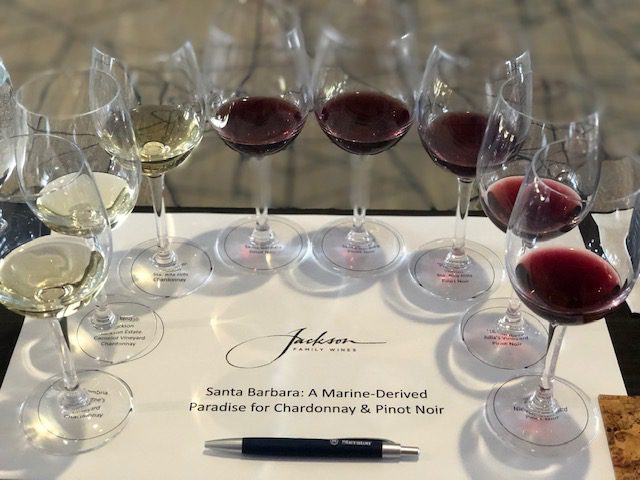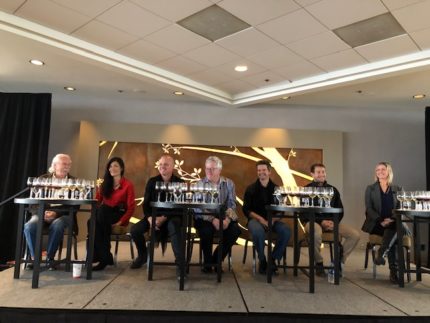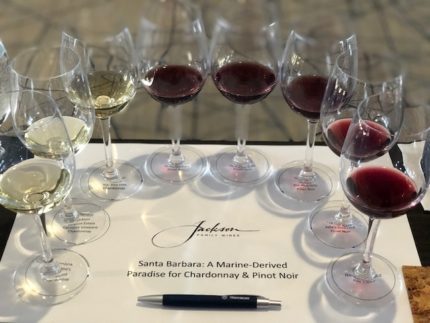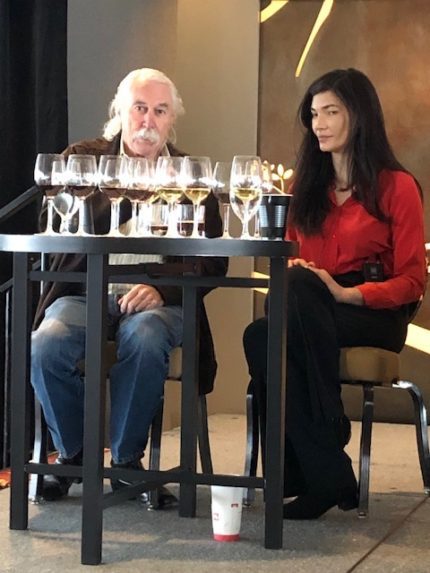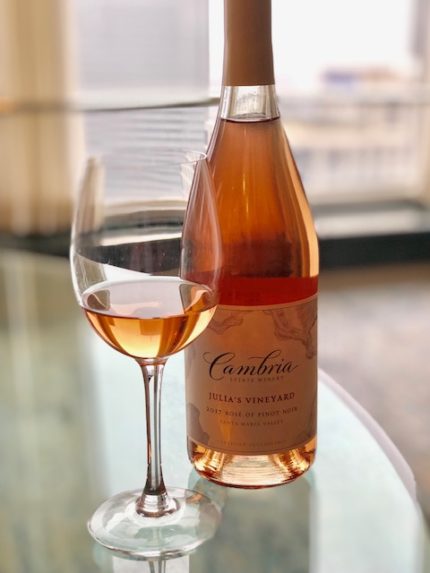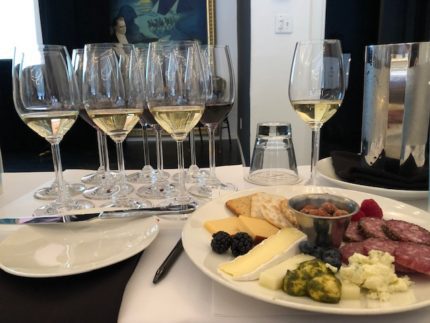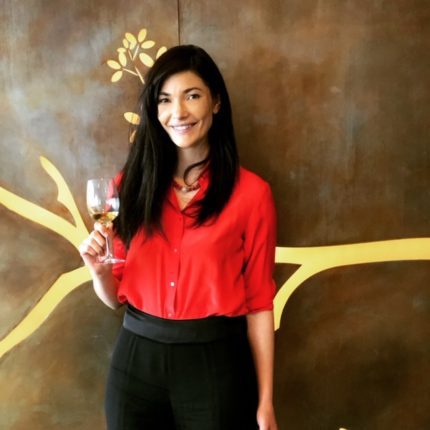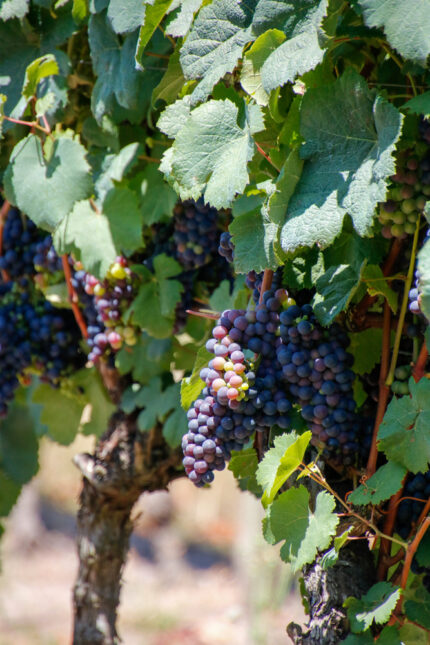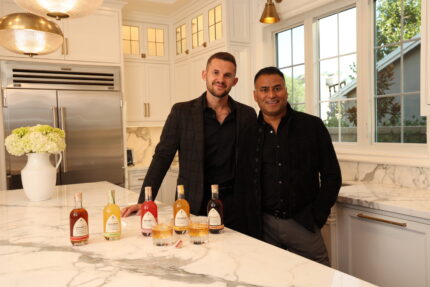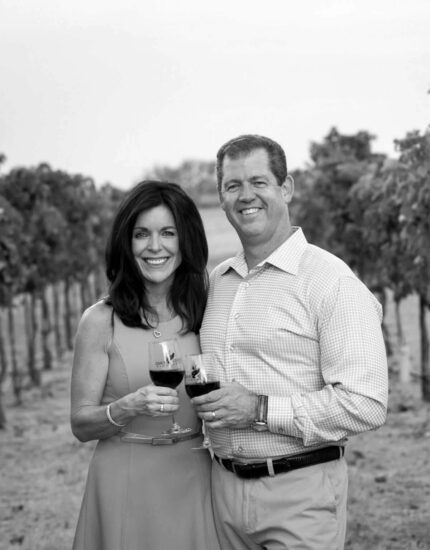Santa Barbara Panelists of Winemakers
The winemakers in the room had a combined 100 years of experience. All with different perspectives on how to farm, manage their vineyards and on their winemaking techniques. But they shared a bond and passion for Santa Barbara and a common owner – Jackson Family Wines.
This was the third Jackson Family Winemaker education session that I’ve attended, and I’m always struck by the comradery. When Jackson Family Wines acquires these vineyards, they actually infuse resources and let them keep on keeping on. That is a quality I respect especially after reading the news this week about Constellation shutting down the Ravenswood tasting room and the worst case implications of what could happen when a conglomerate acquires a boutique winery.
Randy Ullom from Kendall-Jackson and Julia Jackson from Jackson Family Wines
Our panel included Winemakers and Owners – Greg Brewer, of Brewer-Clifton: Jonathan Nagy of Byron; Jill Russell from Cambria; Randy Ullom from Kendall-Jackson; Ryan Pace of Nielson Winery; Adam Lee from Siduri Wines; Julia Jackson from Jackson Family Wines. Gilian Handelman, Jackson Family Wines Vice President of Wine Education, was our moderator. The seminar was entitled “Santa Barbara County, A Marine Derived Paradise for Chardonnay and Pinot Noir.”
Like all other sessions, the panel started with a beverage that represents the region – this time a toast with Shinerbock. You gotta love localization.
Randy Ullom talked about planting what is right and what is wrong over his 44 years at Kendall Jackson (hint: cab is not good in this region.) He talked about when Jess Jackson entered the wine business more than three decades ago, he wanted to create a family enterprise specializing in handmade wines. When Randy was recruited from the Russian River Valley, he thought Jess was crazy to want to go to Santa Barbara. But “lawyers can be very persuasive.”
As Randy started to make the Kendall Jackson Chardonnay, it was nothing like the Russian River style he was used to. It took time, in fact six months to truly come around, but when it did, it was a ‘holy Toledo’ moment.”
Cambria’s Julia’s Vineyard Rose Wine Served When We Arrived
All of the winemakers talked about common themes. How the relationship between the vineyards and man is an ancient and vibrant one. How important land stewardship, cultural preservation, adherence to artisan farming and winemaking is in this region.
The region of Santa Barbara county came about because of a tectonic collision between 15 and 25 million years ago during the Oligocene Epoch, which drove the north-south mountain ranges into an east-west orientation. Santa Barbara is one of the oldest wine producing regions in California. The first grapes were planted in the 1700s by Spanish missionaries and the first commercial vineyard was planted by Uriel Nielson on Santa Maria Bench in 1964, and these grapes are used today in the Bryon Chardonnay.
Santa Barbara County consists of 2,737 square miles with more than 200 wineries ranging in production from 600 to 400,000 cases. Santa Barbara has five approved AVAs and one under consideration. Santa Maria Valley, Santa Ynez Valley, Sta. Rita Hills (changed from Santa Rita Hills upon objections from a Chilean producer with the same name), Happy Canyon, Ballard Canyon and Los Olivos District (not yet formally approved).
The different varieties are Chardonnay (36 percent), Pinot Noir (26 percent), Syrah (9 percent), Sauvignon Blanc (4 percent), Cabernet Sauvignon (3.5 percent), Grenache (2.5 percent) and other varieties (19 percent). The soils change based on the AVAs – from calcareous to pure sand/sand dominated loams to gravels.
Santa Barbara reached the nation’s consciousness with the movie Sideways, which catapulted Pinot Noir in terms of sales and awareness.
Jackson Family Wineries lie exclusively in coastal regions, the “Burgundy belt” of Santa Barbara. We tasted through a number of diverse wines showcasing the style of different AVAs of the region.
The AVAs are very different and therefore, the wines and profiles of the wines can be night and day if tasted side by side, which made this tasting so much fun. We focused on two AVAs in our tasting:
The Santa Maria Valley AVA is 98,790 acres in size with 3,500 planted. The majority of vines are planted between 300 and 800 feet on the slopes of hillsides and you often hear references to “the Santa Maria Bench.” The climate is cool and dry with mixed sandy soils. The Chardonnay is known for its profile of tropical and orange bordering on “exotic” and pinots are described as earth with Asian spice and red fruit. Notable producers are Au Bon Climat, Bien Nacido Vineyards, Bryon, Cambria, Foxen, Native 9, Presqu’ile, Qupe, Riverbench and Scar of the Sea.
The Sta. Rita Hills AVA is 30,000 acres with 3,500 planted. The region has a close proximity to the Pacific funneling cold air with the Purisima, Santa Rita Hills and Santa Ynez Mountains framing the area to the North and South. The climate is cool and dry with sand, sandy clay loam and diatomaceous earth. The Chardonnay is known for citrus and saline notes and Pinot Noir is known for blue and black fruit and tea. Notable producers are Ampelos, Babcock, Brewer-Clifton, Foley, Hilliard Bruce, Loring, Sandhi, Sea Smoke and Tyler (to name a few).
We tried the following wines:
- 2016 Cambria Katherine’s Vineyard Signature Collection Chardonnay
- 2017 Kendall Jackson Estate Camelot Chardonnay, Santa Maria Valley
- 2016 Brewer Clifton Sta. Rita Hills Chardonnay
- 2016 Cambria Julia’s Vineyard Pinot Noir
- 2016 Byron Vineyards & Winery Santa Maria Valley Pinot Noir
- 2016 Nielson Winery Santa Maria Pinot Noir
- 2017 Siduri Santa Barbara County Pinot Noir
- 2016 Brewer Clifton Sta. Rita Hills Pinot Noir
The most fun was hearing how the winemakers described the wines and the regions. It was clear that these winemakers work together well, share best practices and have a banter and appreciation for different styles and winemaking methods.
This was my absolute favorite quote. “This Brewer Clifton Chardonnay reminds me of the ocean … unbridled, yet calm and tranquil,” said Greg Brewer, founder and winemaker. It’s a juxtaposition of circumstance – elusive, yet emotive. “
Julia Jackson, Jackson Family Wines and Founder of Grounded
The coolest part of the event was a side conversation with Julia where she talked about her passion about helping to make an impact with climate change. In fact, she feels so strongly about preserving our ecosystems that she’s started a non-profit organization, Grounded. Grounded held a two-day summit the end of March convening the world’s foremost climate change experts: scientists, activists, world leaders, artists, and business people to educate and share solutions to our climate crisis. Talk about making a difference and inspiring change.
